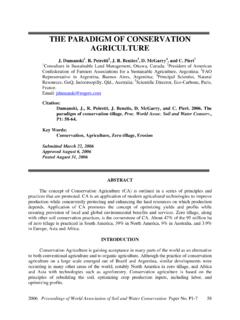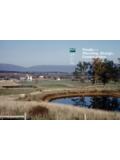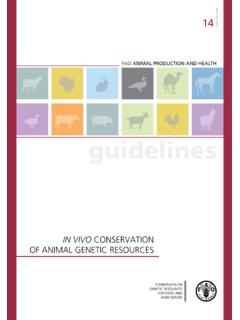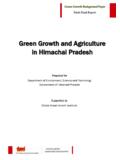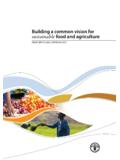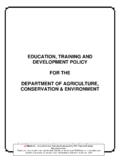Transcription of Conservation-Agriculture Seeders for Smallholder …
1 Conservation-Agriculture Seeders for Smallholder farmers John Morrison1, Joseph Mutua (LoTech), and Harvey Sellner, and Jermaine McGill (WHT). 1. John Morrison Consultant 109 Laurel Lane, Unicoi, TN 37692 USA. BACKGROUND. conservation agriculture (CA) is a set of managerial and technical alternatives which will, in both the short-term and long-term, accomplish the 3-Ws : to store Water in the soil, to save the Water stored in the soil, and to efficiently utilize stored soil Water for beneficial crop production. Water enables agriculture . The active part or focus of conservation in CA is the conservation of available water (Rockstrom, et al. 2009). The focus on water conservation is very helpful, for it provides the following criteria: Any proposed component of CA must be evaluated relative to its potential impact on any or all of the 3-Ws . CA is the best-known method at this time for the accomplishment of current and future food sustainability (Hobbs, 2007).
2 The managerial and technical alternatives alluded to in the above definition of CA indicate that CA is not a fixed one-size-fits-all agricultural cropping procedure, but rather it is a set of alternatives which comply with guiding CA principles. These principles have been found to be valuable, useful, and in some cases necessary to be compatible with, and hopefully accomplish, two of the UN Millennium Development Goals (United Nations, 2000): Goal 1: Eradicate extreme poverty and hunger;. Goal 7: Ensure environmental sustainability. Established CA cropping will produce field conditions with old-crop residues partially-to-fully covering the soil surface. Old-crop stalks/stubble may be standing, lying across the rows, shredded, or flattened by use of a crimper or roller. In addition, FYM and minerals may have been distributed on the surface. CA. Seeders and other mechanization field implements must be successfully operated in these field conditions with minimum disturbance of the soil coverage to maximize soil-water conservation .
3 At this time, for Smallholder village farmers , cropping mechanization may involve manual, animal-draft, and/or 2-wheel tractor (2WT) methods and power sources. All comments, below, are for dryland/rain-fed cropping and may not apply to irrigated cropping. Development of crop Seeders for CA has targeted row-crop seeding under upland, dryland/rain-fed conditions. This target was selected because in many such regions it is water conservation , as provided in CA cropping systems, which is needed for the farmers to produce sustainable livelihoods. Row-crop seeding was selected because grain and oil-seed crops, grown in spaced rows, are their predominate enterprises. The economies of these upland village farmers are minimal, so the goal was to develop and introduce the least costly powered mechanization implements to operate under the field conditions found on such farms. Powered implements were chosen as the next developmental step above manual field operations, and a 1-row seeder powered with a small 2WT was the lowest-cost entry into these CA SEEDER DEVELOPMENT RESULTS.
4 The tasks to be performed with a mechanized crop seeder in non-plowed, residue-covered soils have been determined by experimental-development to be as follows: 1) Initially clear a path through soil-covering stalks and residues for the row to be seeded;. 2) Cut any remaining residues along the initial path;. 3) Open a furrow in the soil to the depth required for seeding;. 4) Meter and deposit seed into the opened furrow;. 5) (Option) Meter and deposit fertilizers or other materials into the opened furrow;. 6) Press the seeded furrow closed;. 7) (Option) Provide a riding platform for the seeder operator. We have determined that for typical small to medium amounts of old-crop residues on dryland/rain-fed CA. fields, that a floating residue-rake wheel mounted at 30 to forward travel can be used to initially clear the bulk of residues from the row path. Remaining residues can be successively cut with a spring-loaded rolling disc blade. This system does not require excessive machine weight and provides for uniform seeding depth.
5 The seeding furrow can be opened with a vertical shank, tipped with a narrow replaceable tip, for most types of soils and conditions. Seed and (optional) non-toxic rates of starter fertilizers can be metered into the opened seed furrow. The seeded furrow can be closed and pressed with a semi-pneumatic presswheel. The operator can stand on foot platforms on the presswheel to provide weight for soil penetration with the seeder components and furrow closing-pressing to finish the operation. Row-crop Seeders for CA which conform to the above functional requirements are now available. The typical configuration is as a 1-row seeder for rear-mounting on a 2WT; 2-row configurations are possible if 2WT traction is not limiting. New animal-draft versions are forthcoming. [disclaimer: the authors are designers and distributors of the Morrison Seeders , CA-Seeder 1000, manufactured under contract by SMTI. of Erwin TN, USA]. APPLICATIONS FOR conservation agriculture .
6 The 1-row CA Seeder described above can be used for the process of successively demonstrating and introducing CA cropping technologies in rural communities. As such, it is offered as a tool to enable these activities. The Seeder is commercially available so that interested farmers may become CA- farmers . EXPERIMENTAL EVIDENCE. The 1-row CA Seeder described above is currently under comparative testing in East Africa and Mexico. Earlier unpublished use of this seeder design since 2009, in pre-production prototypes, has been initially successful in USA, Tanzania, and Ghana. Published results are forthcoming. DISCUSSION. The managerial and technical alternatives of CA cropping are fairly broad in definition, but when it comes to the selection of Seeders and other field implements to accomplish CA cropping, there are but a few options. Depending upon the crops being grown and the field conditions, some mechanization implements are currently available from several sources.
7 If a few cases, there are choices between manufacturers for competitive implements. Selection of appropriate mechanization implements for particular needs should be done under advisement. As developers, distributors, and advocates for CA, we have the responsibility to provide appropriate technologies at affordable prices to support the training programs and initial-adopter farmers as CA moves into the main stream of crop production on Smallholder village farms. REFERENCES. Hobbs, , 2007. conservation agriculture : what is it and why is it important for future sustainable food production? Journal of Agricultural Science, 145, 127-137. Rockstrom, J., P. Kaumbutho, J. Mwalley, A. W. Nzabi, M. Temesgen, L. Mawenya, J. Barron, J. Mutua, and S. Damgaard-Larsen. 2009. conservation farming strategies in East and Southern Africa: Yields and rain water productivity from on-farm action research. Soil & Tillage Research, 103: 23-32. United Nations. 2000.
8 Resolution 55/2 adopted by the General Assembly, United Nations Millennium Declarations , 8th Plenary Meeting, 8 September 2000.

